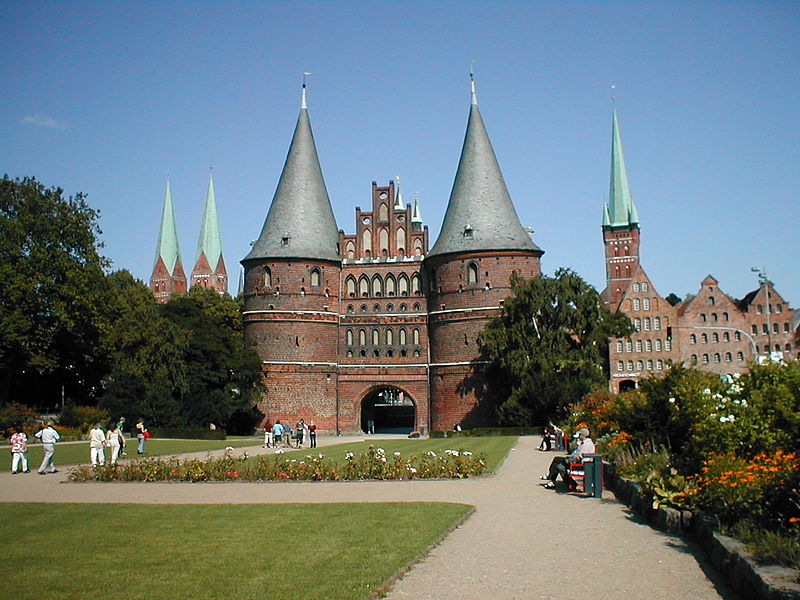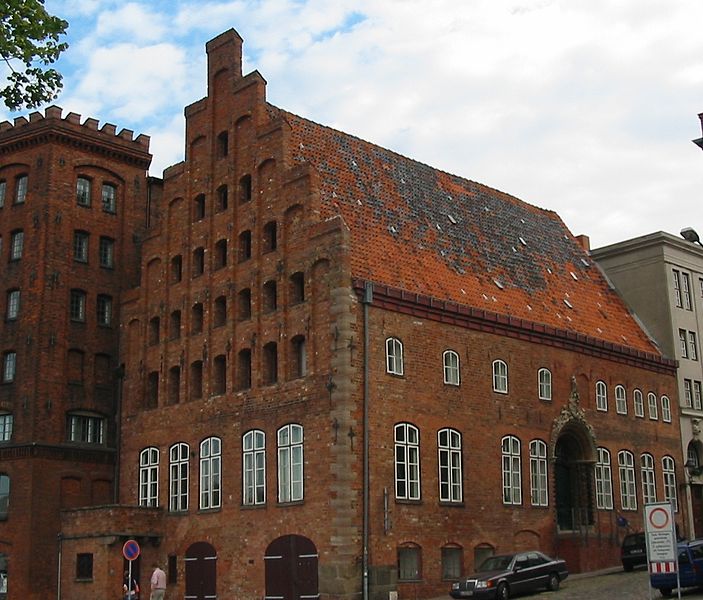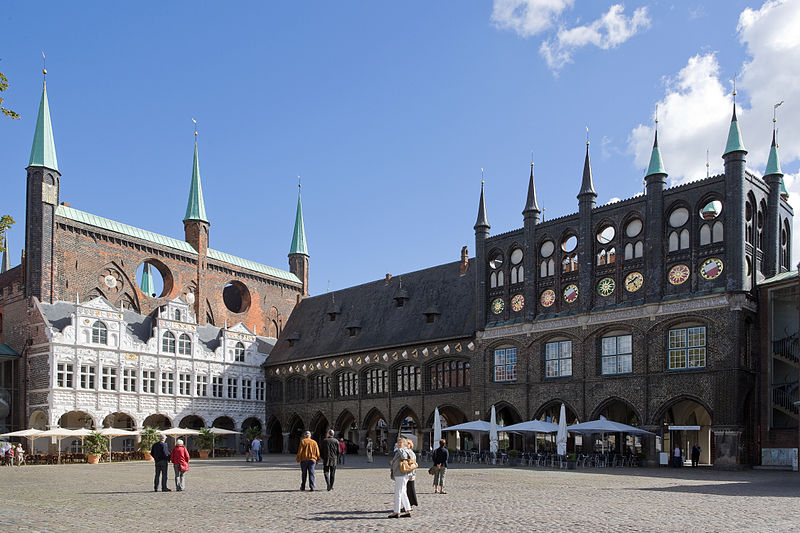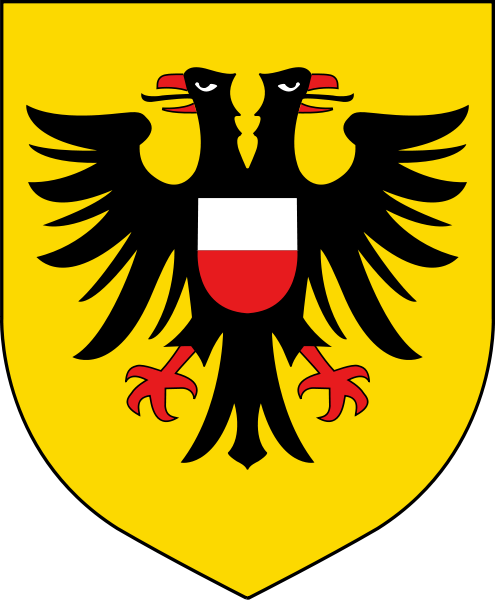<Back to Index>
- Schleswig - Holstein, Germany Lübeck, 210K
PAGE SPONSOR
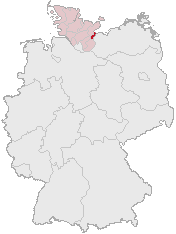
The Hanseatic City of Lübeck is the second largest city in Schleswig - Holstein, in northern Germany, and one of the major ports of Germany. It was for several centuries the "capital" of the Hanseatic League ("Queen of the Hanse") and, because of its Brick Gothic architectural heritage, is listed by UNESCO as a World Heritage Site. In 2005 it had a population of 213,983.
Situated on the river Trave, Lübeck is the largest German port on the Baltic Sea. The old part of the town is an island enclosed by the Trave. The Elbe – Lübeck Canal connects the Trave with the Elbe River. Another important river near the town center is the Wakenitz. The Autobahn 1 connects Lübeck with Hamburg and Denmark (Vogelfluglinie). The borough of Travemünde is a sea resort and ferry port on the coast of the Baltic Sea. Its central station links Lübeck to a number of lines, notably the line to Hamburg.
The area around Lübeck was settled after the last Ice Age. Several Neolithic dolmens can be found in the area.
In addition to this, around AD 700 Slavic peoples started to come into the eastern parts of Holstein which had been evacuated by many Germanic inhabitants in the course of the Migration Period. By the early 9th century Charlemagne, whose Christianization attempts were opposed by Saxons, moved Saxons out and brought in Polabian Slavs, who were allied to Charlemagne, in their stead. Liubice ("lovely") was founded on the banks of the river Trave about four kilometres north of the present day city center of Lübeck. In the 10th century it became the most important settlement of the Obotrite confederacy and a castle was built. The settlement was burned down in 1128 by the pagan Rani from Rügen.
The modern town was founded by Adolf II, Count of Schauenburg and Holstein, in 1143 as a German settlement on the river island Bucu. He established a new castle which was first mentioned by Helmold in 1147. Adolf had to cede the castle to Henry the Lion in 1158. After Henry's fall from power in 1181, the town became an Imperial city for eight years. Emperor Barbarossa gave the city a ruling council with twenty members that survived into the 19th century. This council was dominated by merchants and caused Lübeck's politics to be dominated by trade interests for centuries to come.
The town and castle changed ownership for a period afterwards and was part of the Duchy of Saxony until 1192, of the County of Holstein until 1217 and part of Denmark until the Battle of Bornhöved in 1227.
Around 1200 the port became the main point of departure for colonists leaving for the Baltic territories conquered by the Livonian Order and, later, Teutonic Order. In 1226 Emperor Frederick II elevated the town to the status of an Imperial Free City, by which it became the Free City of Lübeck.
In the 14th century Lübeck became the "Queen of the Hanseatic League", being by far the largest and most powerful member of this mediaeval trade organization. In 1375, Emperor Charles IV named Lübeck one of the five "Glories of the Empire", a title shared with Venice, Rome, Pisa and Florence. Several conflicts about trade privileges were fought by Lübeck and the Hanseatic League against Denmark and Norway with varying outcomes. While Lübeck and the Hanseatic League prevailed in conflicts in 1435 and 1512, Lübeck lost when it became involved in the Count's Feud, a civil war that raged in Denmark from 1534 to 1536. Lübeck also joined the Schmalkaldic League.
After defeat in the Count's Feud, Lübeck's power slowly declined. Lübeck managed to remain neutral in the Thirty Years' War, but with the devastation caused by the decades long war and the new transatlantic orientation of European trade, the Hanseatic League and thus Lübeck lost importance. After the Hanseatic League was de facto disbanded in 1669, Lübeck remained an important trading town on the Baltic Sea.
The great Danish - German composer Dieterich Buxtehude (born in what is present day Sweden) became organist at the Marienkirche in Lübeck in 1668 and remained at the post until at least 1703.
In the course of the war of the Fourth Coalition against Napoleon, troops under Bernadotte occupied the neutral Lübeck after a battle against Blücher on November 6, 1806. Under the Continental System, the bank went into bankruptcy and from 1811 to 1813 Lübeck was formally annexed as part of France until the Vienna Congress of 1815.
In 1937 the Nazis passed the so-called Greater Hamburg Act, whereby the nearby Free and Hanseatic City of Hamburg was expanded, to encompass towns that had formally belonged to the Prussian province of Schleswig - Holstein.
To compensate Prussia for these losses (and partly because Hitler had a
personal dislike for Lübeck after it had refused to allow him to
campaign there in 1932),
the 711 year long independence of Lübeck came to an end and almost
all its territory was incorporated into Schleswig - Holstein.
During World War II, Lübeck was the first German city to be attacked in substantial numbers by the Royal Air Force. The attack on 28 March 1942 created a firestorm, that caused severe damage to the historic center and the Bombing of Lübeck in World War II destroyed three of the main churches and greater parts of the built-up area. A POW camp for officers, Oflag X-C, was located near the city from 1940 until April 1945. Lübeck was occupied without resistance by the British Second Army on 2 May 1945.
On 3 May 1945, one of the biggest disasters in naval history occurred in the Bay of Lübeck when RAF bombers sank three ships - the SS Cap Arcona, the SS Deutschland, and the SS Thielbek - which, unknown to them, were packed with concentration camp inmates. About 7,000 people were killed.
Lübeck's population grew considerably from about 150,000 in 1939 to more than 220,000 after the war, owing to an influx of refugees expelled from the former Eastern provinces of Germany.
Lübeck remained part of Schleswig - Holstein after the war (and consequently lay within West Germany) and was situated directly on the inner German border during the division of Germany into two rival states in the Cold War period. South of the city the border followed the path of the river Wakenitz that separated both countries by less than 10 m (32.81 ft) in many parts. The northernmost border crossing was in Lübeck's district of Schlutup. Lübeck's restored historic city center became a UNESCO World Heritage Site in 1987.
Lübeck was the scene of a notable art scandal in the 1950s. Lothar Malskat was hired to restore the medieval frescoes of the cathedral of the Marienkirche in Lübeck which were discovered inside the walls after the cathedral had been badly damaged during World War II. Instead he painted new works which were passed off as restorations, thereby fooling many experts. The West German government printed 2 million postage stamps depicting the frescoes. Among Malskat's additions were also wild turkeys, which were unknown in Europe during the Middle Ages. Some experts considered this as evidence for the early discovery of America by the Vikings. Malskat later exposed the deception himself. The incident plays a prominent role in Günter Grass's novel The Rat.
On
the night of January, 18th 1996 a fire broke out in a home for foreign
refugees, killing 10 people and severely injuring more than 30 others,
mostly children. While for most of the inhabitants of the shelter a
racist motivation was obvious, the
police and the local court have been accused of having excluded the
motive of a racist act before even beginning preliminary investigations. The incident has not been elucidated to this day.
Much of the old town has kept a medieval look with old buildings and narrow streets. The town once could only be entered by passing one of four town gates, of which two remain today, the well known Holstentor (1478) and the Burgtor (1444).
The old town center is dominated by seven church steeples. The oldest ones are the Lübecker Dom (the city's cathedral) and the Marienkirche (Saint Mary's), both from the 13th and 14th centuries.
Other sights include: the Lübecker Rathaus (Town Hall); Saint Catherine Church, Lübeck, a church that belonged to a former monastery, now the Katharineum, a Latin school; Thomas Mann's house; Günter Grass' house; Church of St. Peter ("Petrikirche"); Church of St. Lawrence, located on the site of a cemetery of people who died during the 16th century plague; Church of St. Jacob (Lübecker Jakobikirche, 1334); Church of St. Aegidien ("Aegidienkirche"); the Salzspeicher, historic warehouses where salt delivered from Lüneburg awaited shipment to Baltic ports.
Like many other places in Germany, Lübeck has a long tradition of a Christmas market in December, which includes the famous handicrafts market inside the Heiligen - Geist - Hospital (Hospital of the Holy Spirit), located at the northern end of Königstrasse.
Lübeck has many smaller museums like the St. Annen Museum, the Behnhaus and the Holstentor. Lübeck Museum of Theatre Puppets is a privately run museum. Waterside attractions are a light vessel that served Fehmarnbelt and Lisa von Lübeck, a reconstruction of a Hanseatic 15th century caravel.
Lübeck is very famous for its excellent marzipan industry, and according to local legend, Marzipan was first made in Lübeck possibly in response to either a military siege of the city, or a famine year. The story, perhaps apocryphal, is that the town ran out of all foods except stored almonds and sugar, and used these to make loaves of marzipan "bread". Others believe that marzipan was actually invented in Persia a few hundred years before Lübeck claims to have invented it. The best known producer is Niederegger, which tourists often visit while in Lübeck, especially at Christmas time.
The Lübeck wine trade dates back to Hanseatic times. One Lübeck specialty is Rotspon, wine made from grapes processed and fermented in France and transported in wooden barrels to Lübeck, where it is stored, aged and bottled.
Lübeck has three universities, Lübeck University of Applied Sciences, University of Lübeck and Musikhochschule Lübeck. The Graduate School for Computing in Medicine and Life Sciences is a central facility of the University and is founded by the German Excellence Initiative. The International School of New Media is an affiliated institute at the University.
Some notable people of the city: Hans Blumenberg – philosopher; Willy Brandt – chancellor; Ephraim Carlebach – rabbi; Felix Carlebach – rabbi; Joseph Carlebach – rabbi; Björn Engholm – politician; Christian Friedrich Heinecken – child prodigy; Godfrey Kneller – painter; Heinrich Mann – novelist; Thomas Mann – novelist; Sandra Völker – swimmer; Dieterich Buxtehude – composer and organist.
The
industrial Lübeck - Herrenwyk area was until the beginning of 1990s
the location of a big metallurgical plant. The gas produced by this
plant was used for making electricity in the Lübeck - Herrenwyk power
station. In 1992, the Lübeck - Herrenwyk power station was
demolished after the bankruptcy and demolition of the metallurgical
plant and since 1994 its site houses the static inverter plant of the HVDC Baltic - Cable.
